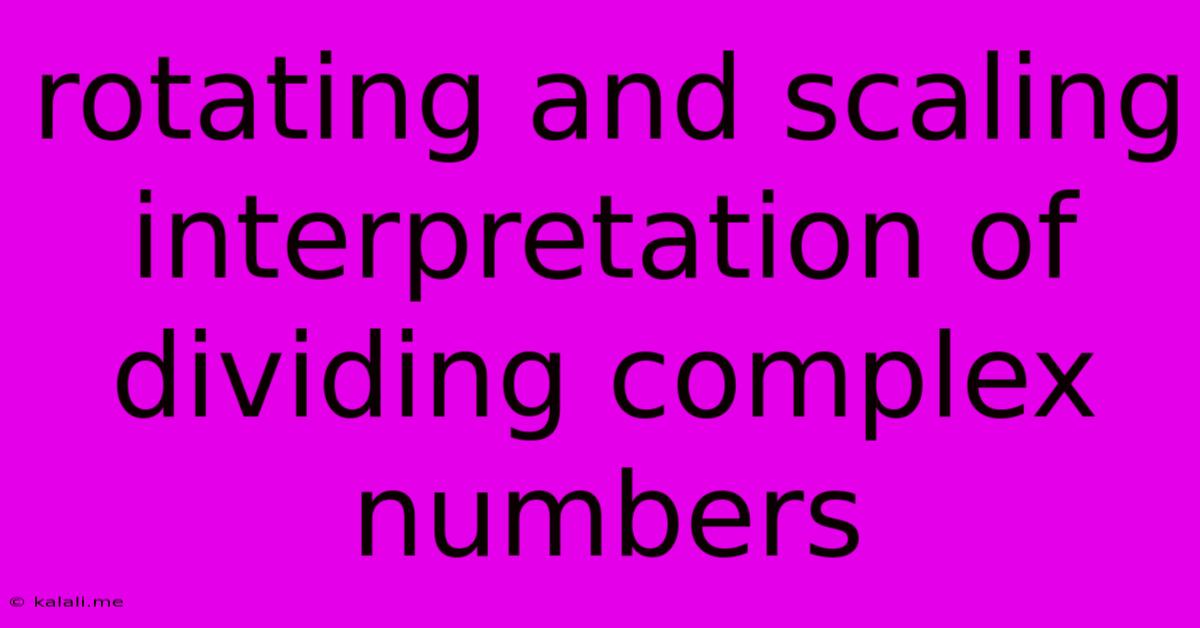Rotating And Scaling Interpretation Of Dividing Complex Numbers
Kalali
May 23, 2025 · 3 min read

Table of Contents
Rotating and Scaling: A Geometric Interpretation of Complex Number Division
Dividing complex numbers might seem like a purely algebraic operation, but it holds a beautiful geometric interpretation involving rotation and scaling in the complex plane. Understanding this geometric perspective provides deeper insight into the nature of complex numbers and their operations. This article will explore how division of complex numbers can be visualized as a combination of rotation and scaling, enhancing your understanding of complex analysis.
What are complex numbers? Before diving into the geometric interpretation, let's briefly revisit the definition of complex numbers. A complex number z is expressed in the form a + bi, where a and b are real numbers, and i is the imaginary unit (√-1). We can represent a complex number graphically on a complex plane, with the real part (a) on the x-axis and the imaginary part (b) on the y-axis. This representation allows us to visualize complex numbers as points or vectors.
Polar Form: The Key to Geometric Understanding
The key to unlocking the geometric interpretation of complex number division lies in expressing complex numbers in polar form. The polar form represents a complex number using its magnitude (distance from the origin) and argument (angle from the positive x-axis). We can convert a complex number from rectangular form (a + bi) to polar form (r(cos θ + i sin θ) or r cis θ) using the following relationships:
- r = |z| = √(a² + b²) (magnitude or modulus)
- θ = arg(z) = arctan(b/a) (argument or phase)
Division as Rotation and Scaling
Now, let's consider the division of two complex numbers, z₁/z₂. If z₁ = r₁(cos θ₁ + i sin θ₁) and z₂ = r₂(cos θ₂ + i sin θ₂), then the division can be expressed as:
z₁/z₂ = [r₁(cos θ₁ + i sin θ₁)] / [r₂(cos θ₂ + i sin θ₂)] = (r₁/r₂) [cos(θ₁ - θ₂) + i sin(θ₁ - θ₂)]
This equation reveals the geometric significance of complex number division:
-
Scaling: The magnitude of the resulting complex number is the ratio of the magnitudes of the original numbers (r₁/r₂). This represents a scaling operation. If r₁/r₂ > 1, the result is scaled up; if r₁/r₂ < 1, it's scaled down.
-
Rotation: The argument of the resulting complex number is the difference between the arguments of the original numbers (θ₁ - θ₂). This signifies a rotation. The complex number z₁ is rotated counter-clockwise by the angle θ₂ around the origin.
Example:
Let's illustrate this with an example. Consider z₁ = 2 + 2i and z₂ = 1 + i.
-
Convert to Polar Form:
- z₁: r₁ = √(2² + 2²) = 2√2; θ₁ = arctan(2/2) = π/4
- z₂: r₂ = √(1² + 1²) = √2; θ₂ = arctan(1/1) = π/4
-
Perform Division:
- z₁/z₂ = (2√2 cis π/4) / (√2 cis π/4) = 2 cis 0 = 2
In this example, the division results in a scaling by a factor of 2 and no rotation (rotation by 0 radians).
Conclusion:
The geometric interpretation of complex number division as a combination of scaling and rotation provides a powerful visual tool for understanding this operation. By viewing complex numbers as vectors in the complex plane and using their polar form, we can grasp the effect of division intuitively. This understanding is not only insightful but also crucial for advanced concepts in complex analysis and its applications in various fields like signal processing and physics. This richer understanding allows for a more intuitive approach to solving problems and appreciating the elegance of complex numbers.
Latest Posts
Latest Posts
-
Error Bios Legacy Boot Of Uefi Only Media
May 23, 2025
-
How Can You Tell If Chicken Is Done
May 23, 2025
-
Why Is Milk Pasteurized Before Making Cheese
May 23, 2025
-
Why Tangent Space Of The Abelian Differential Is Relative Cohomology
May 23, 2025
-
How Long Can Bacon Last In The Fridge
May 23, 2025
Related Post
Thank you for visiting our website which covers about Rotating And Scaling Interpretation Of Dividing Complex Numbers . We hope the information provided has been useful to you. Feel free to contact us if you have any questions or need further assistance. See you next time and don't miss to bookmark.